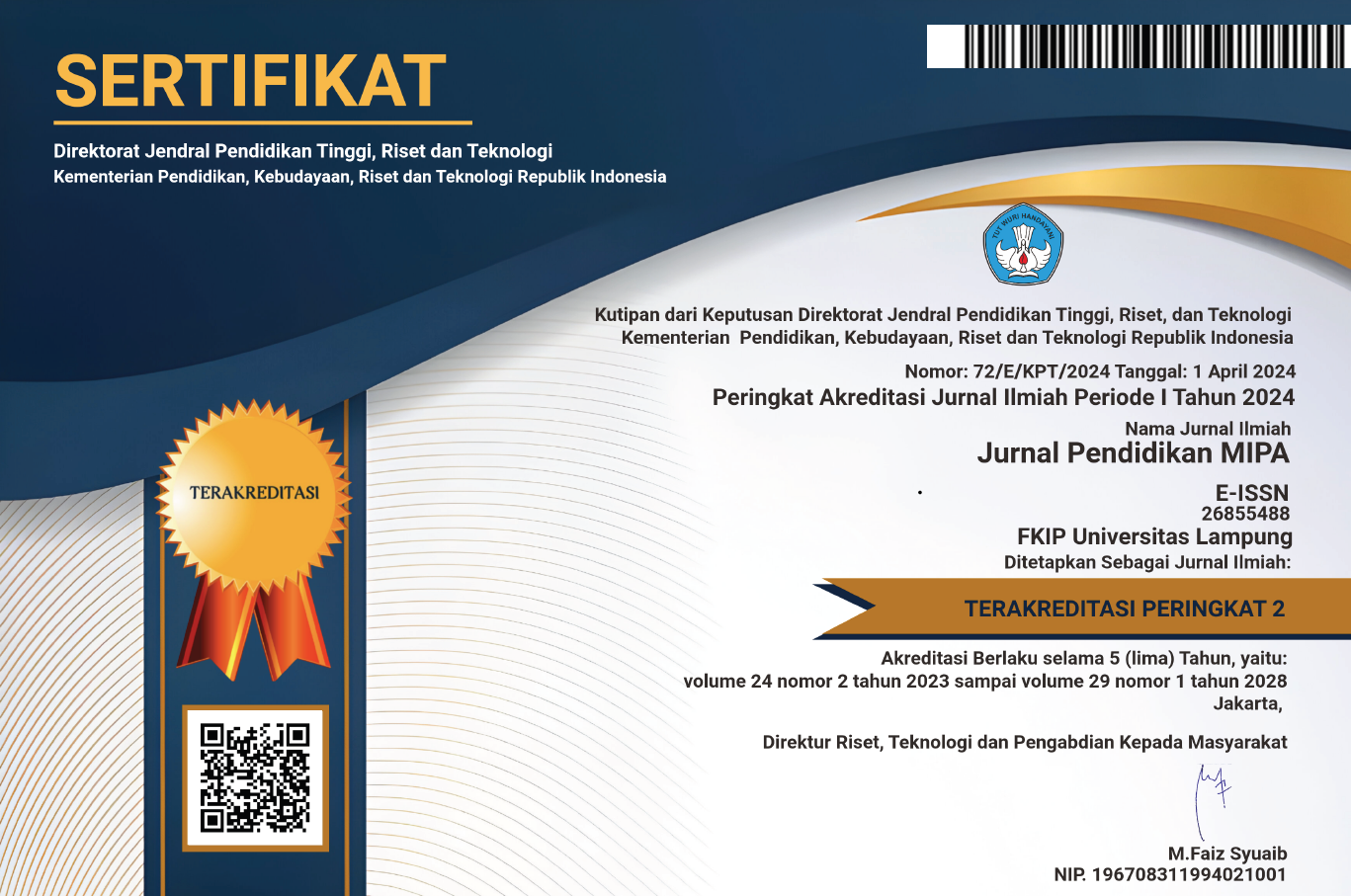Abilities and Difficulties of Ninth-Grade Students in Solving Geometry Transformation Problems
 Country:
Country:
(1) Universitas Syiah Kuala, Indonesia
(2) Universitas Syiah Kuala, Indonesia
(3) Universitas Syiah Kuala, Indonesia
Geometry is one of the challenging subjects for students. This study aimed to determine the ability of students to solve geometric transformation problems, the difficulties they experienced, and the causes. This research employed a mixed method with a sequential explanatory design. Eight Year 9 students were the subjects of this study. Data were collected through tests and interviews. The data were analyzed quantitatively, followed by qualitative analysis involving reducing data, presenting data, and concluding. The results indicated that the student's ability to solve geometric transformation problems was moderate. Students found it difficult to solve geometric transformation problems. The student's difficulties included determining the translation when a starting point and an image point were given and determining the image of a point/curve by a transformation. Students had not fully mastered the schemes in the geometric transformation, were not proficient in using formulas, and were not precise in their calculations.
Keywords: students’ difficulty, transformation, translation, rotation, dilatation.
Ada, T., & Kurtulus, A. (2010). Students’ misconceptions and errors in transformation geometry. International Journal of Mathematical Education in Science and Technology, 41(7), 901–909.
Aini, A. N., Mukhlis, M., Annizar, A. M., Jakaria, M. H. D., & Septiadi, D. D. (2020). Creative thinking level of visual-spatial students on geometry HOTS problems. Journal of Physics: Conference Series, 1465(1), 12054.
Alghadari, F., Herman, T., & Prabawanto, S. (2020). Factors affecting senior high school students to solve three-dimensional geometry problems. International Electronic Journal of Mathematics Education, 15(3), em0590.
Andamon, J. C., & Tan, D. A. (2018). Conceptual understanding, attitude, and performance in mathematics of grade 7 students. International Journal of Scientific & Technology Research, 7(8), 96–105.
Bisson, M.-J., Gilmore, C., Inglis, M., & Jones, I. (2016). Measuring conceptual understanding using comparative judgement. International Journal of Research in Undergraduate Mathematics Education, 2(2), 141–164.
Cirillo, M., & Hummer, J. (2021). Competencies and behaviors observed when students solve geometry proof problems: An interview study with smartpen technology. ZDM–Mathematics Education, 53(4), 861–875.
Creswell, J. W. (2012). Research design: Pendekatan kualitatif, kuantitatif, dan campuran [Research design: Qualitative, quantitative, and mixed approaches]. Pustaka Belajar.
DeJarnette, A. F., & González, G. (2016). Thematic analysis of students’ talk while solving a real-world problem in geometry. Linguistics and Education, 35, 37–49.
Hardiyanti, A. (2016). Analisis kesulitan siswa kelas IX SMP dalam menyelesaikan soal pada materi barisan dan deret [Analysis of the difficulties of class IX junior high school students in solving problems on sequences and series material]. Prosiding Konferensi Nasional Penelitian Matematika Dan Pembelajarannya (KNPMP I) UMS, 78–88.
Kemendikbud. (2018). Laporan hasil ujian nasional [Report on national exam results]. Retrieved from https://hasilun.puspendik.kemdikbud.go.id/#2019!smp!capaian_nasional!99&99&999!T&T&T&T&1&!1!&
Kribbs, E. E., & Rogowsky, B. A. (2016). A review of the effects of visual-spatial representations and heuristics on word problem solving in middle school mathematics. International Journal of Research in Education and Science, 2(1), 65–74.
Luneta, K. (2015). Understanding students’ misconceptions: An analysis of final Grade 12 examination questions in geometry. Pythagoras, 36(1), 1–11.
Maulani, I. F., & Zanthy, S. L. (2020). Analisis kesulitan siswa dalam menyelesaikan soal materi transformasi geometri [Analysis of students' difficulties in solving geometry transformation material questions]. Jurnal Gammath, 5(1), 16–25.
Miles, M. B., & Huberman, A. M. (2007). Analisis data kualitatif buku sumber tentang metode-metode baru [Qualitative data analysis of source books on new methods]. (Tjepjep Rohendi Rohidi, Ed.) Universitas Indonesia.
Russell, J. L., Correnti, R., Stein, M. K., Thomas, A., Bill, V., & Speranzo, L. (2020). Mathematics coaching for conceptual understanding: Promising evidence regarding the Tennessee math coaching model. Educational Evaluation and Policy Analysis, 42(3), 439–466.
Seloraji, P., & Eu, L. K. (2017). Students’ performance in geometrical reflection using Geogebra. Malaysian Online Journal of Educational Technology, 5(1), 65–77.
Septyawan, S. R., Suryadi, D., Hidayat, C. R., Rosjanuardi, R., Juandi, D., Wahyuningrum, A. S., & Suryadi, D. (2019). Analysis of learning obstacles on transformation geometry, 6–11.
Sudijono, A. (2009). Pengantar statistik pendidikan [Introduction to educational statistics]. Rajawali Pers.
Sugiyono. (2015). Metode penelitian pendidikan pendekatan kuantitatif, kuantitatif, dan R&D [Research Methods: Quantitative, Qualitative, and R&D Approaches]. Alfabeta.
Suherman, E. (2003). Strategi pembelajaran matematika kontemporer [Contemporary Mathematics Learning Strategies]. Jica.
Sulistiowati, D. L., Herman, T., & Jupri, A. (2019). Student difficulties in solving geometry problems based on Van Hiele thinking level. Journal of Physics: Conference Series, 1157(4), 42118.
Yanik, H. B. (2014). Middle-school students’ concept images of geometric translations. The Journal of Mathematical Behavior, 36, 33–50.
Refbacks
- There are currently no refbacks.

This work is licensed under a Creative Commons Attribution-ShareAlike 4.0 International License.






